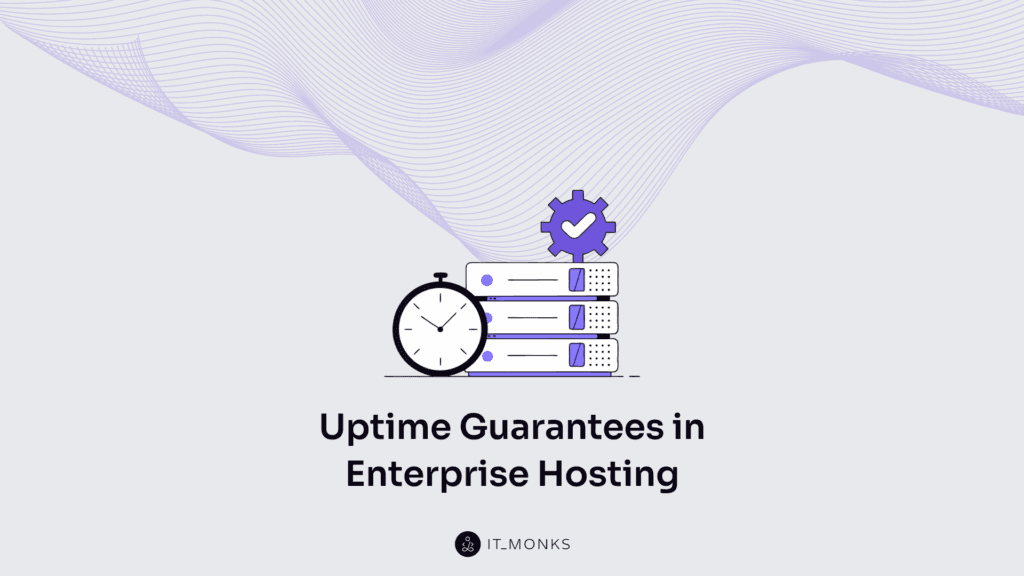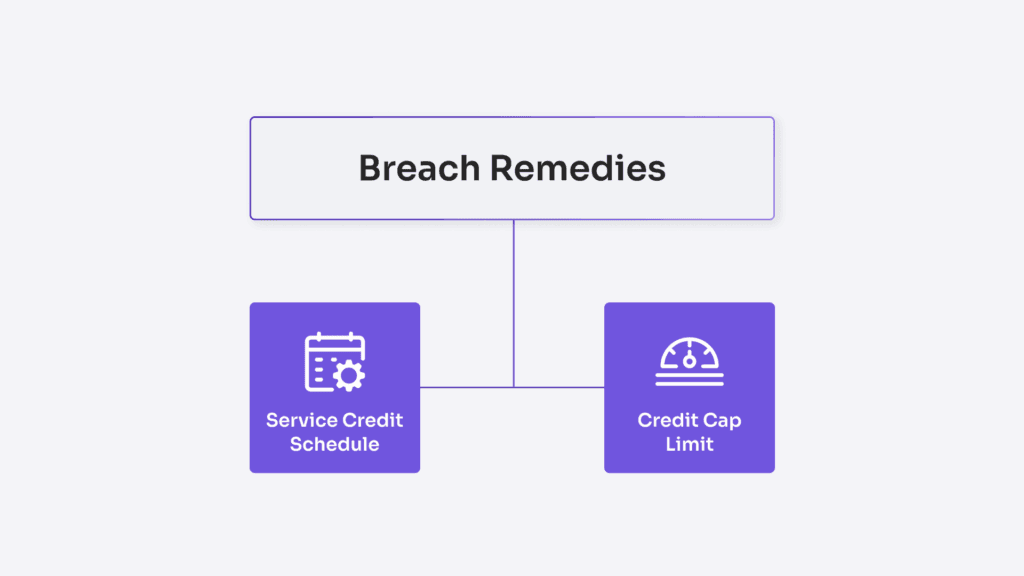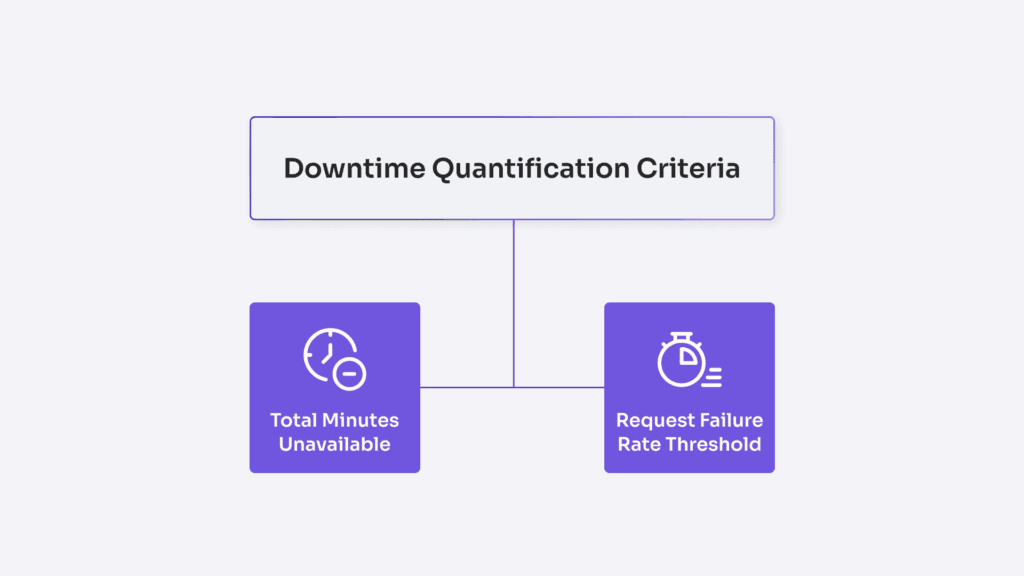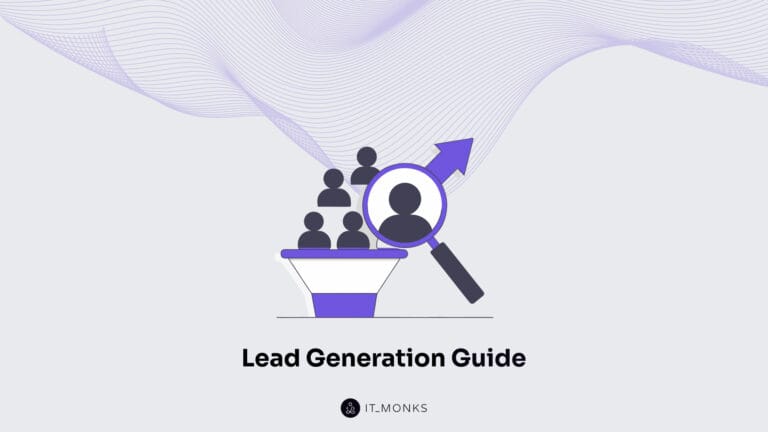Uptime Guarantees in Enterprise Hosting
Table of Contents

Uptime guarantees are essential performance indicators affecting operational continuity, trustworthiness, and service reputation of enterprise websites. In enterprise hosting, they are formalized within service level agreements as specific percentile uptime metrics, serving as both technical benchmarks and contractual obligations.
These guarantees specify how much downtime is acceptable within a defined measurement window, as outlined in the uptime assurance clauses of the SLA, translating abstract availability into enforceable performance standards.
An enterprise website requires guaranteed uptime as a condition for service continuity, user access, and compliance. Availability guarantees like 99.9%, 99.99%, or 99.999% are tied directly to infrastructure-level SLA terms and quantified by the minute. Each level corresponds to a quantified service interruption window, which must be minimized and monitored. These metrics govern everything from customer trust to legal accountability through enforceable SLA conditions.
Hosting providers are expected to measure, enforce, and report these thresholds consistently. The SLA binds these metrics to response actions, defining breach consequences and exceptions. These structured commitments form the foundation for how service reliability is both promised and penalized in enterprise hosting environments.
SLA Availability Target
SLA availability targets define uptime thresholds in enterprise hosting environments as measurable, contract-bound service level benchmarks that establish a performance threshold for system availability. Expressed as percentages, 99.9%, 99.99%, and 99.999%, these targets quantify system availability over specific service windows and set enforceable limits on allowable downtime. Each percentage correlates to a specific maximum allowable downtime per calendar month, creating a measurable uptime commitment.
These targets are not abstract metrics; they represent operational baselines for enterprise website accessibility. Hosting providers use them to structure SLA compliance matrices, classify service tiers, and trigger breach remedies when thresholds are not met.
Each tier standardizes a reliability expectation within the SLA compliance matrix, linking specific uptime targets to infrastructural requirements and contractual remedies. These availability tiers function as value nodes in a structured SLA model, where each target carries distinct infrastructure demands and breach thresholds.
Higher availability levels require more resilient architectures and support a lower tolerance for failure. The tiered model allows for precise alignment between hosting maturity and business risk expectations.
99.9% Uptime
99.9% uptime defines a baseline SLA availability target with a monthly downtime allowance of up to 43.83 minutes, or roughly 8.76 hours per year. It represents the contractual minimum for entry-level enterprise hosting, typically supported by single-region infrastructure without failover or advanced redundancy.
This level of uptime applies to enterprise websites with low downtime sensitivity, internal dashboards, batch reporting tools, or non-customer-facing platforms. Availability monitoring at this tier is usually limited to basic uptime tracking windows and threshold-based alerting, with fewer enforcement mechanisms. Enforcement at this level rarely includes automated SLA breach escalations or penalty triggers, making uptime monitoring more observational than contractual.
As the lowest viable SLA for enterprise deployments, 99.9% represents a cost-driven trade-off. It supports operations where service reliability matters, but tolerance for short outages remains acceptable. It sits below the next tier, 99.99%, which introduces more resilient architecture and tighter enforcement for critical applications.
99.99% Uptime
99.99% uptime is a mid-tier SLA value with heightened availability expectations and tighter downtime tolerances. It represents a monthly availability ceiling of roughly 4.38 minutes. Compared to the 99,9% baseline, this level demands tighter fault tolerance, reducing service disruption while avoiding the cost of absolute uptime.
Reaching 99.99% uptime requires multi-zone redundancy, active failover clusters, and health-aware load balancing. Infrastructure at this level distributes workloads across isolated fault domains, minimizing the blast radius of local failures.
Violations at this tier may trigger SLA penalty clauses, reinforcing the need for proactive monitoring and incident response agility. SLA enforcement typically includes real-time availability tracking, alert thresholds, and response-time validation to maintain compliance.
Such SLA value supports enterprise websites like SaaS dashboards, eCommerce portals, and authenticated user services that rely on stable uptime but can tolerate minimal interruptions. These platforms often operate within a strict uptime fault window where even a few minutes of downtime can affect revenue or user trust.
It delivers meaningful risk reduction without the operational overhead required by the highest availability class. Systems needing zero-failure tolerance, such as financial trading or clinical platforms, fall outside this availability envelope and push into the next SLA tier.
99.999% Uptime
99.999% uptime is the highest-tier SLA benchmark offered in enterprise hosting environments. It sets the strictest availability ceiling in enterprise hosting, allowing no more than 26.3 seconds of downtime per month.
Achieving this uptime tier requires a multi-active architecture with synchronous replication, sub-minute failover, and autonomous self-healing infrastructure across geographically isolated zones. High-frequency, compliance-grade monitoring guarantees detection of service faults within sub-minute windows, enabling immediate automated mitigation.
This tier is designed for critical enterprise websites, banking systems, emergency portals, and medical telemetry, where service interruption is unacceptable. These sectors demand 99.999% assurance as a contractual condition for operational viability.
SLA enforcement at this level mandates penalty clauses, third-party verification, and binding legal frameworks tailored for zero-tolerance environments.
Breach Remedies

Breach remedies are predefined contractual actions triggered when the enterprise hosting SLA fails to meet its uptime commitments. If availability drops below agreed thresholds, such as 99.9%, 99.99%, or 99.999%, within a defined measurement window, the provider is obligated to apply compensatory mechanisms.
Once a service level breach, defined by uptime shortfall against SLA thresholds, is confirmed, the remedy process is activated by provider-side monitoring or a subscriber-initiated claim.
The structure includes 2 core components: the service credit schedule and the credit cap limit. The service credit schedule governs how compensation is calculated based on downtime severity. The credit cap limit sets a ceiling on total compensation within a billing cycle.
Remedies are applied via remedy activation protocols when measurable indicators, such as downtime minutes or request failure rates, exceed the SLA’s defined thresholds. Credit entitlement follows strict eligibility logic, grounded in uptime data and breach classification.
Claims must be filed within the prescribed window, with disputes escalated as defined in the contract. This window typically aligns with defined measurement periods, such as a calendar month or rolling 30-day window.
These remedies are built into the SLA to compensate for provider noncompliance and protect the operational integrity of the enterprise website.
Service Credit Schedule
The service credit schedule defines a structured, percentage-based billing adjustment applied when uptime falls below SLA targets. It specifies fixed compensation tiers mapped to uptime deviation brackets.
Such tiers follow a formal credit eligibility matrix based on specific uptime thresholds.
For example, availability between 99.89% and 99.5% may trigger a 10% credit, while uptime below 99% can entitle the enterprise website to a 25% offset on the monthly hosting fee.
Credits apply only to the billing cycle in which the breach occurred, are non-refundable, non-transferable, and may be used solely as future service offsets.
Eligibility requires verification of the SLA breach through logs or monitoring tools.
In most cases, a claim must be submitted by the customer within a defined period, typically 30 days after the breach.
The service credit payout operates under enforceable contract terms and is subject to limitations defined in the credit cap limit.
Credit Cap Limit
The credit cap limit is a predefined limit on the total amount of credit that can be applied, regardless of the severity of the downtime breach. It sets a strict upper boundary on the total financial compensation an enterprise website can receive for SLA violations within a given billing period.
Expressed as a percentage of the monthly hosting invoice, commonly between 10% and 15%, this contractual credit maximum governs the highest amount issuable, regardless of how low uptime drops or how many breach thresholds are triggered. For example, a 15% cap on a $10,000 monthly fee translates to a maximum credit of $1,500, even if multiple SLA violations occur during the same cycle.
This monthly credit ceiling is restricted to the impacted billing month and cannot be transferred or accrued. It does not roll over, stack across billing cycles, or increase with additional violations.
The cap functions in tandem with the service credit schedule, meaning credits for individual SLA shortfalls accumulate only until they reach this fixed threshold. Beyond this point, no further compensation is available, even if additional breaches occur within the same billing cycle.
As defined within the SLA agreement, this liability control clause is non-negotiable and embedded directly into the contractual framework. Its role is to contain provider risk exposure while establishing a predictable credit enforcement limit for enterprise clients.
For any compensation to be issued up to the cap, all claim conditions outlined in the SLA must still be met. This ensures that the cap governs the maximum payout but does not override claim eligibility requirements.
Measurement Window
The measurement window is a specific, contractual period used to monitor, aggregate, and assess service uptime performance. This availability tracking span sets the boundaries for aggregating downtime minutes, recognizing SLA violations, and activating service credits.
It governs the breach recognition period and determines the credit assessment timeframe for SLA enforcement. By framing the scope of SLA compliance checks, the measurement window directly controls how availability tracking is operationalized.
Uptime percentages, such as 99.9% or 99.99%, are calculated across this uptime evaluation span, and any shortfall triggers applicable breach remedies. Tools that validate SLA metrics operate within this defined window to ensure accurate performance assessments. It determines both when an SLA violation is detected and when service credit eligibility begins.
Enterprise hosting contracts typically define the measurement window using either a fixed calendar month or a rolling 30-day period. Each window introduces distinct conditions for breach visibility and credit activation timing.
Calendar Month
A calendar month is a static, non-rolling evaluation frame used in many traditional enterprise hosting agreements. It establishes the static time-limited scope in which uptime for the enterprise website is tracked and assessed against SLA availability targets.
SLA breaches are assessed strictly within the calendar-aligned window, with no carryover logic across evaluation periods. This time-limited SLA scope applies to all downtime aggregation and governs when breach remedies become applicable. If an incident crosses into a new month but doesn’t reduce either month’s availability below the threshold, no credit is issued.
This time-locked structure aligns with monthly billing cycles and simplifies reporting and credit scheduling. Its predictability and billing alignment make it a preferred enforcement model in traditional enterprise hosting agreements. However, because each month is treated in isolation, certain outages may fall outside remedy eligibility unless their full impact is contained within a single evaluation period.
Other formats, such as the rolling 30-day window, address this limitation by enabling continuous uptime tracking across overlapping periods.
Rolling 30-day Window
A rolling 30-day window is a 30-day trailing period that updates daily, hourly, or even in real-time, depending on the monitoring system. Unlike fixed monthly frames, this method applies non-static measurement logic, continuously recalculating SLA compliance without reset boundaries. Each new outage is assessed against the prior 720 hours, ensuring continuous uptime evaluation without delay or reset.
For enterprise websites, a rolling 30-day window creates a constantly updating view of service availability, where every incident is tracked within an uninterrupted SLA frame. Such an approach enables dynamic breach recognition, making it essential for enterprise websites that support mission-critical functions.
It shortens SLA enforcement timelines and eliminates the ability to obscure downtime within fixed monthly cutoffs. The real-time SLA tracking increases monitoring precision and improves accountability for providers.
This structure may introduce operational overhead for hosting providers. However, it strengthens credit eligibility and clarifies breach conditions for enterprise website owners.
For uptime thresholds like 99.99%, the rolling 30-day window supports tighter compliance and faster credit activation, making it a preferred model where SLA enforcement must match real-world uptime demands.
Unlike the calendar month approach, which delays detection until fixed intervals elapse, the rolling model enforces SLA standards in near real-time.
Downtime Quantification Criteria

Downtime quantification criteria define the rule set used to measure and validate service interruptions on the enterprise website. These criteria translate technical failures into enforceable SLA breach events. Two measurement models define how downtime is quantified: total minutes of unavailability and request failure rate. Each provides a distinct metric for identifying whether uptime targets have been missed.
Total minutes unavailable tracks the duration the site is non-responsive or inaccessible, based on continuous monitoring. Request failure rate measures the percentage of failed service requests within a defined window, serving as a breach indicator even when the site remains technically accessible. Both models serve as breach triggers when thresholds are exceeded.
All downtime measurements must be supported by monitoring logs, access data, or response error rates. These inputs function as the validation basis for proving SLA threshold violations. They determine whether an event meets the SLA’s quantified outage thresholds.
Once validated, a breach triggers service credit eligibility and influences uptime percentage calculations. The criteria ensure that downtime is measured consistently, based on verified metrics, not assumptions.
Total Minutes Unavailable
Total minutes unavailable refers to the total cumulative time during which the enterprise website was completely inaccessible or non-operational due to provider-side issues. This downtime is logged in minute-based increments by automated monitoring systems that verify complete service disruption across core functional endpoints.
Only full qualifying outages are included; non-qualifying degradations are excluded unless explicitly covered by the SLA scope. Each qualifying incident is logged, timestamped, and added to a rolling counter tied to the active measurement window, either a calendar month or a rolling 30-day period. This counter aggregates each verified outage into a unified system unavailability metric tied to the relevant SLA period.
The rolling counter acts as a contractual enforcement input for SLA validation cycles.
This value serves as the downtime input in the standard SLA uptime formula:
Availability = ((Total Time − Downtime) / Total Time) × 100
It functions as the primary availability calculation input used to determine SLA compliance status. Failure to meet the target initiates the corresponding service credit enforcement mechanisms.
Applicability exclusions, such as scheduled maintenance and customer-induced downtime, are excluded from the calculation to preserve SLA scope integrity.
Total minutes unavailable serves as the contractual time-based breach metric, directly influencing SLA availability validation and triggering service credit eligibility.
It is also used to inform historical SLA audits and long-term reliability assessments for the enterprise website’s hosting environment.
Request Failure Rate Threshold
Request failure rate threshold is the predefined percentage of failed requests (e.g., HTTP 5xx errors, timeouts, or system rejections) that constitutes a service degradation event. It qualifies service degradation based on error frequency rather than outright inaccessibility.
Request failure rate threshold quantifies service degradation by measuring within a defined time interval the percentage of failed requests, typically HTTP 5xx errors, timeouts, or protocol-level rejections. A request is considered failed if it returns an HTTP 5xx error, times out, or triggers a protocol-level rejection.
The failure rate is calculated as:
Failed Requests ÷ Total Requests (within a set window)
For example, if more than 5% of total requests fail within a 5-minute monitoring interval, the system qualifies that segment as a breach-triggering event. The SLA sets this threshold, commonly 5% over 5 minutes, as the trigger point for downtime classification. When this threshold is met or exceeded, the interval is flagged as downtime and contributes to the total minutes unavailable.
The failure events are automatically detected, verified through request error logs, and used to trigger SLA breach responses.
This threshold ties request-level performance to contractual obligations, aligning partial outages with breach conditions under the downtime quantification criteria. It also serves as an input into credit determination under the service credit schedule.
SLA Applicability Exclusions
SLA applicability exclusions are the explicit set of conditions under which SLA uptime targets and breach remedies do not apply. In enterprise website hosting, these contractually fixed clauses set the boundaries for breach calculations and credit eligibility.
Each exclusion is predefined, documented, and enforceable based on the hosting agreement. Such predefined disqualification conditions form the SLA boundary logic that ensures uptime accountability only for controllable service incidents.
Excluded downtime does not count toward total minutes unavailable or impact the request failure rate threshold. It is also excluded from triggering the service credit schedule. These exclusions function as liability shields, limiting breach exposure to failures within the provider’s control and reinforcing security standards for enterprise hosting.
There are 3 core exclusion types: scheduled maintenance, force majeure, and customer-caused incidents. Each disqualifies specific downtime from breach eligibility. Recognition typically requires provider-side verification, such as system logs, maintenance notices, or event records, and must adhere to the hosting agreement’s procedural requirements.
These clauses define the formal limits of SLA applicability as non-creditable outages governed by contractual exclusion clauses.
Scheduled Maintenance
Scheduled maintenance is a planned service unavailability initiated by the provider for system updates, security patches, hardware upgrades, or infrastructure improvements.
Such activities are governed by a contractual maintenance allowance defined within the hosting agreement. To qualify for scheduled maintenance, the provider must give at least 48 hours’ advance notice via agreed channels, usually email or a customer portal.
In some agreements, customer acknowledgment of the notice, either through portal login or email confirmation, is also required to validate the exemption. The event must occur during a defined SLA-neutral maintenance window, typically between 12:00 AM and 4:00 AM local time, and must not exceed a 2-hour duration.
Downtime during a valid maintenance window is not included in total minutes unavailable or request failure metrics. This exemption directly applies to the hosted enterprise website, shielding it from downtime credit triggers during qualified maintenance. However, failure to meet the notice requirement, exceed the time cap, or operate outside the approved window voids the exclusion, reclassifying the downtime as a breach-triggering event subject to SLA credit enforcement.
Force Majeure
Force majeure is a set of extraordinary, non-provider-caused events, typically including natural disasters, wars, terrorism, pandemics, governmental restrictions, and power grid failures, that render the provider unable to deliver hosting services.
These events, when they render hosting operations non-functional despite mitigation efforts, qualify as triggers for SLA enforcement suspension. The clause applies only when the event makes service delivery impossible despite reasonable mitigation efforts.
To invoke this exclusion, the provider must notify the client within the defined timeframe and submit an incident report clearly documenting how the event caused the outage. Without this, the exemption is void.
Once a force majeure event is validated, it directly alters how downtime is classified in SLA calculations. When valid, affected downtime is disqualified from total minutes unavailable, excluded from request failure rate calculations, and ineligible for service credits.
This legal exemption is strictly interpreted. It cannot be used retroactively or as a blanket waiver. Proof is mandatory, review is often required, and service recovery efforts must continue regardless of exemption status. This clause functions as a narrowly applied safeguard and does not relieve the provider from recovery obligations or operational diligence.
Customer-Caused Incidents
Customer-caused incidents are any service disruption triggered by customer misconfiguration, unauthorized changes, unsupported integrations, abuse of resources, or failure to follow support guidance.
These include deploying unstable code, misconfiguring DNS, disabling required monitoring agents, exceeding resource limits, or integrating unsupported services. Such client-side faults trigger downtime but are not counted toward total minutes unavailable or the request failure rate threshold.
Customer-caused incidents disqualify affected periods from service credit eligibility. To enforce this exclusion, the provider must supply clear evidence, logs, timestamps, and config histories linking the disruption to a specific customer action. Without this traceable link, the exclusion doesn’t apply.
This clause ensures the provider isn’t held liable for failures beyond their control. Disputed cases may be resolved through joint technical review or formal escalation per contract terms.
Contact
Don't like forms?
Shoot us an email at [email protected]




